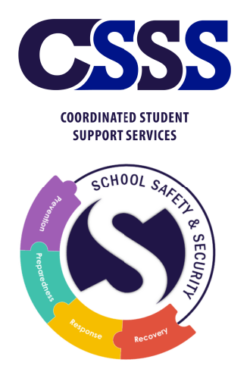LOCKDOWN – SRP Specific Core Action

 LOCKDOWN action is called when there is something dangerous inside the building or school. Students and staff should be in a locked room with lights off and out of sight through any windows providing a sight path into the locked space. A LOCKDOWN is only initiated when there is an active threat inside or very close to the building. The release of students after a lockdown event often is a controlled reunification with parents. The event may be perceived as an actual threat but turn out to be a “SWATTING” event which is when bad actors call into a dispatch center with the report of a bombing or a shooting event at a school that is NOT true resulting in first responders responding as if it were a real event leading to a LOCKDOWN.
LOCKDOWN action is called when there is something dangerous inside the building or school. Students and staff should be in a locked room with lights off and out of sight through any windows providing a sight path into the locked space. A LOCKDOWN is only initiated when there is an active threat inside or very close to the building. The release of students after a lockdown event often is a controlled reunification with parents. The event may be perceived as an actual threat but turn out to be a “SWATTING” event which is when bad actors call into a dispatch center with the report of a bombing or a shooting event at a school that is NOT true resulting in first responders responding as if it were a real event leading to a LOCKDOWN.
Examples of when a LOCKDOWN might be used:
- An active assailant inside the school.
- A perceived assailant inside a school known as SWATTING.
- Intruder in the building.
- Dangerous animal entered the school.
- Report of a weapon on campus.
Who initiates a LOCKDOWN and who has responsibilities?
When there is a life safety threat on campus, a Lockdown should be immediately initiated by any student or staff member. Initiating the Lockdown may happen through various methods, or a combination of methods, depending on the procedures and alert systems utilized by each school and district.
Lockdown alerts may be made by word of mouth, phone, radio systems, intercom, panic buttons, or more advanced forms of technology.
The classroom teacher is responsible for implementing their classroom Lockdown. A If it is safe to do so, the teacher should gather students into the classroom prior to locking the door. The teacher should lock all classroom access
points and facilitate moving occupants out of sight.
A “safe zone” should also be identified within the classroom that is out of sight of interior windows. Teachers and students should be trained to not open the classroom door, leaving a first responder, school safety team member, or school administrator to unlock it.
Contingencies:
Students and staff who are outside of classrooms when a Lockdown is announced should try to get into the closest available classroom, or room with a door that can be secured. In the event someone cannot get into a room before doors are locked, they should be instructed about other options. In this situation, students and staff should be trained to get out of sight or even evacuate themselves away from the building or area. Students and staff should receive training on where to self-evacuate so they can be safe and accounted for.
If during a Lockdown an additional hazard manifests inside the school such as a fire, flood, or hazmat incident, then situational decisions must be made. There should be discussions about reacting to a fire alarm if it is activated during a Lockdown. This may require following additional directives of the SRP.
What should parents do during a lockdown?
Parents should not come to the school as it is likely law enforcement is enroute and no one would be allowed in or out of the school and could lead to congestion for first responders’ ability to do their job.
Communication between a parent and child during a LOCKDOWN is not advisable during the initial stages of a lockdown. The school recognizes the importance of communication between parents and students during a Lockdown event. Parents should be aware though, during the initial period of a Lockdown, it may NOT be safe for students to even text their parents. As the situation resolves, students may be able to communicate with parents on a regular basis. In some actual situations cell towers were overloaded with an inability to communicate which led to more stress for the child and parent(s). It can be tough to do, but parents should be patient during these types of situations.
Parents should also be aware that the duration of a lockdown depends on the series of events pertaining to the incident. Some actual events have taken several hours before reunification with parents have happened.
A release after a LOCKDOWN action
If an actual violent incident occurs, expect that the building will be evacuated by Law Enforcement since it has become a crime scene.
This is just one example of why it is essential to include Local Law Enforcement in your prevention, preparedness, response and recovery planning.
Law Enforcement may also dictate when to release students during a SWATTING or other false event.
The reunification site with parents can be either on site or off site. This is why a LOCKDOWN requires community partners to be involved with the planning to be prepared for these potential events.
Parent Messaging when a school experienced a LOCKDOWN:
If a Lockdown will be followed by an off-site evacuation, get that information out as quickly as possible. Include the information here, or in a separate communication thread.
CURRENT LOCKDOWN
Email
Subject Line: Safety Notification – Lockdown Currently Activated at [School Name]
Dear Parent or Guardian,
[School Name] is currently in Lockdown due to [state the facts you know about the situation]. The safety and well-being of your child is our top priority. We are actively responding to the situation and collaborating with emergency responders.
At this time, we ask that parents stay where they are and remain available to receive updates and instructions as needed.
Watch for updates here [link to the platform you’ll be updating]
What is a Lockdown? *
Text Message
[School Name] is currently in Lockdown. Check your email or voicemail for more information. Please stay where you are and remain available at this time. Check here [link to social media page/site] for updates.
Phone Call
Parents, [School Name] is currently in Lockdown due to [state the facts you know about the situation]. At this time, we ask that parents stay where they are and
remain available to receive updates and instructions as needed. Check our [social media page/site] for ongoing updates.
*Lockdown is called when there is a threat or hazard inside the school building. The Lockdown Action advises making rooms look unoccupied by locking individual classroom doors, offices, and other securable areas, moving occupants out of the line of sight of corridor windows, turning off lights, and having occupants maintain silence.
If students are unable to get behind a locked door, they are trained to self-evacuate.
If your child contacts you to let you know that they safely self-evacuated, please contact the district at [District Phone Number or Safety Hotline] to notify us your child is safe.
For additional information download the SRP/SRM Operational Guide.






